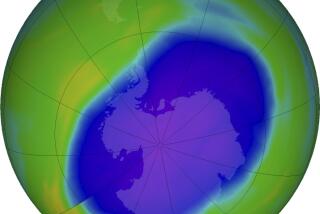Potential New Ozone Hole Alarms U.S. Science Team
- Share via
WASHINGTON — Conditions over the Arctic are ripe for the development of an ozone “hole” comparable to that discovered over the opposite pole five years ago, government scientists said Monday.
The possibility of severe depletion of the ozone layer over the Arctic, in addition to the already-reported thinning of the ozone layer elsewhere, has heightened concerns among medical experts about the potential for higher levels of skin cancer, cataracts and immune-system damage that can result from exposure to the sun’s rays.
Considering their findings alarming enough to release them in the middle of a study that is still under way, the scientists said that they have recorded the highest levels of ozone-damaging chemicals ever detected--some over heavily populated areas of New England and Canada.
In addition, they have found diminished levels of nitrogen oxides, which act to protect the ozone layer in the atmosphere.
Whether the depletion in the north follows the pattern over the Antarctic depends on what happens to a huge, shifting mass of cold air in the region. But one researcher said that existing conditions suggest an ozone loss in the northernmost latitudes of 30% to 40%.
“We are going to be extremely surprised if we go up there and do not see measurable ozone loss,” said Michael J. Kurylo, manager of the National Aeronautics and Space Administration’s upper atmosphere research program.
The latest evidence of ozone destruction produced new calls for faster action to ban chlorofluorocarbons, commonly called CFCs, and halons and other chlorine-based industrial chemicals blamed for damage to the protective blanket of ozone in the earth’s upper atmosphere.
Since discovery of the Antarctic ozone hole more than five years ago, scientists also have found thinning of the layer in the middle latitudes. That development led the Environmental Protection Agency to estimate last year that the next half-century will see as many as 12 million additional skin cancer cases, and perhaps 200,000 more deaths.
Scientists conducting the Arctic observations--sponsored by NASA, the National Oceanic and Atmospheric Administration and the National Science Foundation--based their grim forecast on the discovery of surprisingly high levels of ozone-killing chemicals.
Flights by modified U-2 reconnaissance planes last month detected the highest levels of chlorine monoxide ever recorded in the atmosphere, reaching as far south as New England and eastern Canada, according to Harvard chemist James G. Anderson.
Flights originating in Bangor, Me., encountered dramatically increased levels of chlorine north of the city before even reaching their planned altitude of above 60,000 feet.
At the same time, instruments recorded lower than expected levels of nitrogen oxides, which serve to slow the chemical process of ozone destruction.
Both ozone and nitrogen oxides are key pollutants in urban smog. But in the stratosphere, ozone blocks the ultraviolet radiation that causes skin cancer. Nitrogen oxides serve to fight off the buildup of chlorine and bromines, which cause ozone to break up.
Besides finding conditions suggesting potential ozone destruction comparable to that around the South Pole, the instruments taking the most recent soundings have provided the foundation for the most detailed ozone chemistry studies yet accomplished.
Already, the results show that CFCs are even more efficient at destroying the ozone than scientists had believed. It is now clear, Anderson said, that pervasive high levels of chlorine compounds exist in the stratosphere from the mid-Caribbean to the Arctic, with the more benign forms constantly being transformed into the more destructive.
The use of CFCs, long employed in chemicals such as the Freon used in refrigerators and air conditioners, has dropped dramatically and they are no longer used as propellants for hair spray and deodorant cans.
Pressure to continue their use comes mainly in developing countries where refrigeration and air conditioning are just beginning to be used on a massive scale.
Next November, 74 nations that have signed the so-called Montreal Protocol banning CFC use by the year 2000 will meet in Copenhagen to update the international agreement for the fourth time. Efforts to move the deadline from the year 2000 to 1995 are expected there, as are tighter controls on the chlorine-based CFC substitutes.
“It is time,” said Liz Cook, an ozone specialist for the environmental group, Friends of the Earth, “for U.S. government policy on ozone depletion to catch up with the scientific knowledge.”
After last year’s new EPA skin cancer projections, environmental activists in Congress called for an emergency meeting of signatories to the Montreal Protocol.






